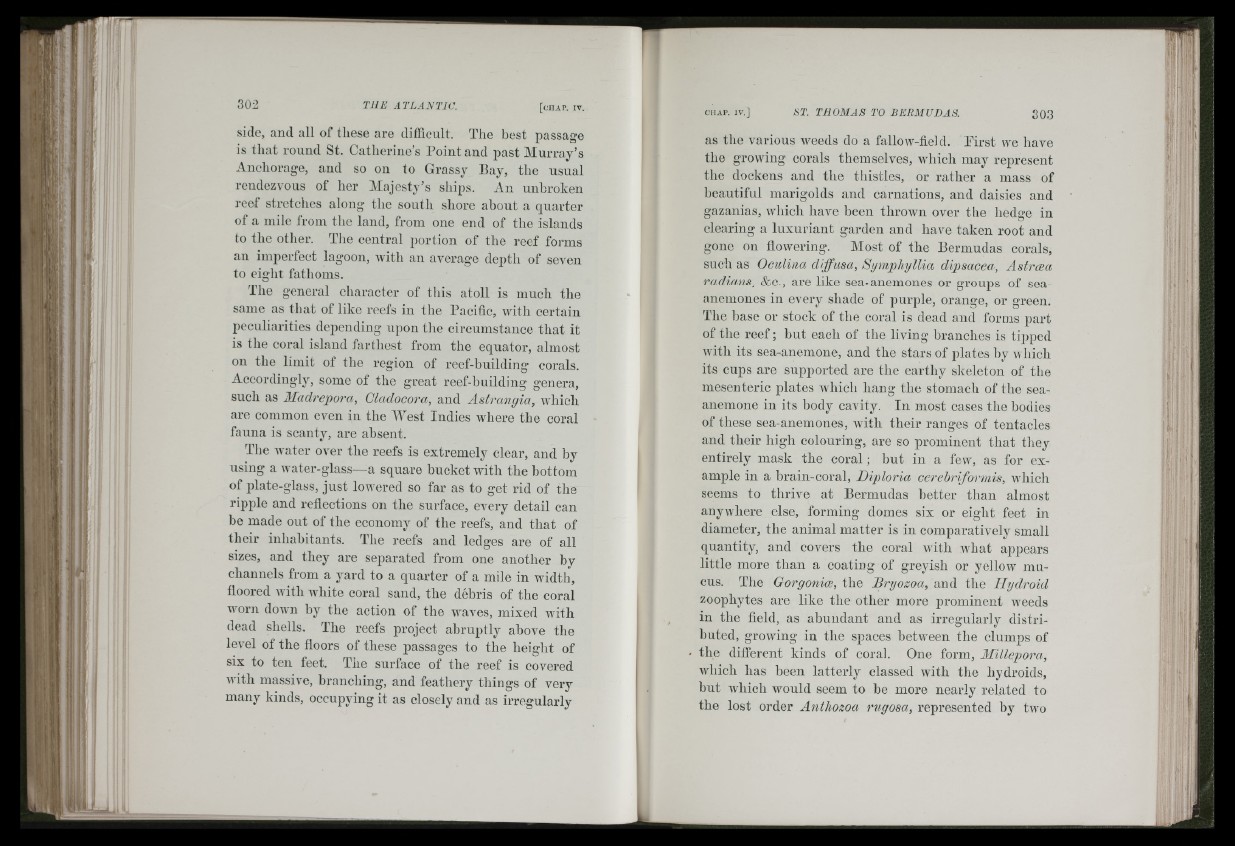
side, and all of tliese are difficult. The best passage
is tbat round St. Catherine’s Point and past Murray’s
Anchorage, and so on to Grassy Bay, tbe usual
rendezvous of her Myjesty’s ships. An unbroken
reef stretches along tlie south shore about a quarter
of a mile from tbe land, from one end of the islands
to tbe otber. Tbe central portion of tbe reef forms
an imperfect lagoon, with an average deptb of seven
to eight fathoms.
Tbe general character of tliis atoll is much tbe
same as tbat of like reefs in tbe Pacific, with certain
peculiarities depending upon the circumstance tbat it
is the coral island farthest from tbe equator, almost
on tbe limit of tbe region of reef-building corals.
Accordingly, some of tbe great reef-building genera,
such as Madrepora, Cladocora, and Astrangia, whicli
are common even in the West Indies where the coral
fauna is scanty, are absent.
The water over the reefs is extremely clear, and by
using a water-glass—a square bucket with the bottom
of plate-glass, just Imvered so far as to get rid of the
ripple and reflections on the surface, every detail can
be made out of the economy of the reefs, and that of
their inhabitants. The reefs and ledges are of all
sizes, and the}' are separated from one another by
channels from a yard to a quarter of a mile in tvidth,
floored with white coral sand, the débris of the coral
worn down hy the action of the ivaves, mixed with
dead shells. The reefs project abruptly above the
level of the floors of these passages to the height of
six to ten feet. The surface of the reef is covered
Avith massive, branching, and feathery things of very
many kinds, occupying it as closely and as irregularly
as the various Aveeds do a fallow-field. Pirst we have
the growing corals themselves, which may represent
the dockens and the thistles, or rather a mass of
beautiful marigolds and carnations, and daisies and
gazanias, Avhich have been throAA'ii over tbe liedge in
clearing a luxuriant garden and have taken root and
gone on flowering. Alost of the Bermudas corals,
such as Oculina diffusa, Symphyllia dipsácea, Astrcca
radians, &c., are like sea-anemones or groups of sea-
anemones in every shade of purple, orange, or green.
The base or stock of the coral is dead and forms part
of the r e e f; but each of the living branches is tipped
Avith its sea-anemone, and the stars of plates hy which
its cups are supported are the earthy skeleton of the
mesenteric plates Avhich hang the stomach of the sea-
anemone in its body cavity. In most cases the bodies
of these sea-anemones, Avith their ranges of tentacles
and their high colouring, are so prominent that they
entirely mask the co ra l; hut in a few, as for example
in a brain-coral, Diploria cerebriformis, which
seems to thrÍA'0 at Bermudas better than almost
anywhere else, forming domes six or eight feet in
diameter, the animal matter is in comparatively small
quantity, and covers the coral Avith Avbat appears
little more than a coating of greyish or yelloAV mn-
cus. The GorgonicB, the Bryozoa, and the Ilydroid
zoophytes are like the other more prominent weeds
in the field, as abundant and as irregularly distrihuted,
groAving in the spaces between the clumps of
the diiferent kinds of coral. One form, Millepora,
Avhich has been latterly classed with tlie hydroids,
but which would seem to be more nearly related to
the lost order Antliozoa rugosa, represented by two
iknif, h;!
lit-; 8 • ÍÍ at) K j,..- íùli'fîfrk îi-!îiÜ|.Î.
:tlil ilSl!
m -
::|-îrî î."*' I Didh
p .
J, X
H*|J,
’ I il ii; :